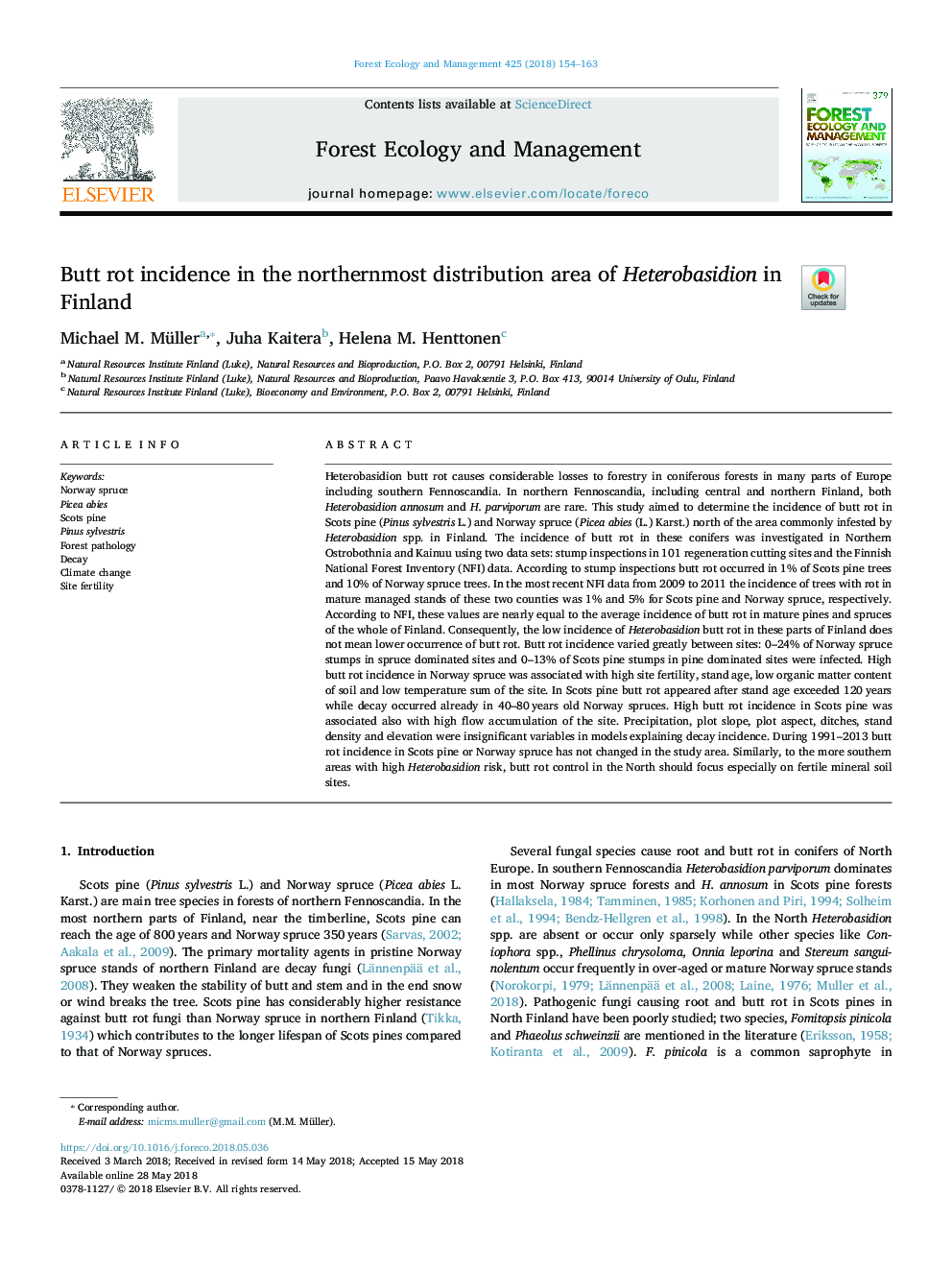| کد مقاله | کد نشریه | سال انتشار | مقاله انگلیسی | نسخه تمام متن |
|---|---|---|---|---|
| 6541571 | 1421335 | 2018 | 10 صفحه PDF | دانلود رایگان |
عنوان انگلیسی مقاله ISI
Butt rot incidence in the northernmost distribution area of Heterobasidion in Finland
دانلود مقاله + سفارش ترجمه
دانلود مقاله ISI انگلیسی
رایگان برای ایرانیان
کلمات کلیدی
موضوعات مرتبط
علوم زیستی و بیوفناوری
علوم کشاورزی و بیولوژیک
بوم شناسی، تکامل، رفتار و سامانه شناسی
پیش نمایش صفحه اول مقاله

چکیده انگلیسی
Heterobasidion butt rot causes considerable losses to forestry in coniferous forests in many parts of Europe including southern Fennoscandia. In northern Fennoscandia, including central and northern Finland, both Heterobasidion annosum and H. parviporum are rare. This study aimed to determine the incidence of butt rot in Scots pine (Pinus sylvestris L.) and Norway spruce (Picea abies (L.) Karst.) north of the area commonly infested by Heterobasidion spp. in Finland. The incidence of butt rot in these conifers was investigated in Northern Ostrobothnia and Kainuu using two data sets: stump inspections in 101 regeneration cutting sites and the Finnish National Forest Inventory (NFI) data. According to stump inspections butt rot occurred in 1% of Scots pine trees and 10% of Norway spruce trees. In the most recent NFI data from 2009 to 2011 the incidence of trees with rot in mature managed stands of these two counties was 1% and 5% for Scots pine and Norway spruce, respectively. According to NFI, these values are nearly equal to the average incidence of butt rot in mature pines and spruces of the whole of Finland. Consequently, the low incidence of Heterobasidion butt rot in these parts of Finland does not mean lower occurrence of butt rot. Butt rot incidence varied greatly between sites: 0-24% of Norway spruce stumps in spruce dominated sites and 0-13% of Scots pine stumps in pine dominated sites were infected. High butt rot incidence in Norway spruce was associated with high site fertility, stand age, low organic matter content of soil and low temperature sum of the site. In Scots pine butt rot appeared after stand age exceeded 120â¯years while decay occurred already in 40-80â¯years old Norway spruces. High butt rot incidence in Scots pine was associated also with high flow accumulation of the site. Precipitation, plot slope, plot aspect, ditches, stand density and elevation were insignificant variables in models explaining decay incidence. During 1991-2013 butt rot incidence in Scots pine or Norway spruce has not changed in the study area. Similarly, to the more southern areas with high Heterobasidion risk, butt rot control in the North should focus especially on fertile mineral soil sites.
ناشر
Database: Elsevier - ScienceDirect (ساینس دایرکت)
Journal: Forest Ecology and Management - Volume 425, 1 October 2018, Pages 154-163
Journal: Forest Ecology and Management - Volume 425, 1 October 2018, Pages 154-163
نویسندگان
Michael M. Müller, Juha Kaitera, Helena M. Henttonen,